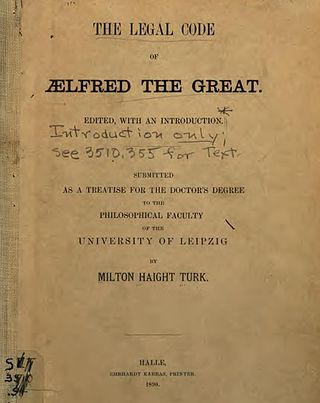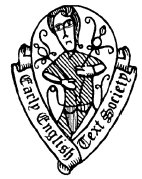Related Research Articles

Matthew Paris, also known as Matthew of Paris, was an English Benedictine monk, chronicler, artist in illuminated manuscripts, and cartographer who was based at St Albans Abbey in Hertfordshire. He authored a number of historical works, many of which he scribed and illuminated himself, typically in drawings partly coloured with watercolour washes, sometimes called "tinted drawings". Some were written in Latin, others in Anglo-Norman or French verse. He is sometimes confused with the nonexistent Matthew of Westminster.

In Christianity, an anchorite or anchoret is someone who, for religious reasons, withdraws from secular society to be able to lead an intensely prayer-orientated, ascetic, or Eucharist-focused life. Anchorites are frequently considered to be a type of hermit, but unlike hermits, they were required to take a vow of stability of place, opting for permanent enclosure in cells often attached to churches. Also unlike hermits, anchorites were subject to a religious rite of consecration that closely resembled the funeral rite, following which they would be considered dead to the world and a type of living saint. Anchorites had a certain autonomy, as they did not answer to any ecclesiastical authority apart from bishops.
That is an English language word used for several grammatical purposes. These include use as an adjective, conjunction, pronoun, adverb, and intensifier; it has distance from the speaker, as opposed to words like this. The word did not originally exist in Old English, and its concept was represented by þe. Once it came into being, it was spelt as þæt, taking the role of the modern that. It also took on the role of the modern word what, though this has since changed, and that has recently replaced some usage of the modern which. Pronunciation of the word varies according to its role within a sentence, with two main varieties, though there are also regional differences, such as where the sound is substituted instead by a in English spoken in Cameroon.

The "Gawain Poet", or less commonly the "Pearl Poet", is the name given to the author of Sir Gawain and the Green Knight, an alliterative poem written in 14th-century Middle English. Its author appears also to have written the poems Pearl, Patience, and Cleanness; some scholars suggest the author may also have composed Saint Erkenwald. Save for the last, all these works are known from a single surviving manuscript, the British Library holding 'Cotton MS' Nero A.x. This body of work includes some of the most highly-regarded poetry written in Middle English.

Pearl is a late 14th-century Middle English poem that is considered one of the most important surviving Middle English works. With elements of medieval allegory and from the dream vision genre, the poem is written in a North-West Midlands variety of Middle English and is highly—though not consistently—alliterative; there is, among other stylistic features, a complex system of stanza-linking.

Ancrene Wisse is an anonymous monastic rule for female anchoresses written in the early 13th century.
Cleanness is a Middle English alliterative poem written in the late 14th century. Its unknown author, designated the Pearl poet or Gawain poet, also appears, on the basis of dialect and stylistic evidence, to be the author of Sir Gawain and the Green Knight, Pearl, and Patience, and may have also composed St. Erkenwald.

The Doom Book, Dōmbōc, Code of Alfred or Legal Code of Ælfred the Great was the code of laws compiled by Alfred the Great. Alfred codified three prior Saxon codes – those of Æthelberht of Kent, Ine of Wessex and Offa of Mercia – to which he prefixed the Ten Commandments of Moses and incorporated rules of life from the Mosaic Code and the Christian code of ethics.

The Early English Text Society (EETS) is a text publication society founded in 1864 which is dedicated to the editing and publication of early English texts, especially those only available in manuscript. Most of its volumes contain editions of Middle English or Old English texts. It is known for being the first to print many important English manuscripts, including Cotton Nero A.x, which contains Pearl, Sir Gawain and the Green Knight, and other poems.
Layamon's Brut, also known as The Chronicle of Britain, is a Middle English alliterative verse poem compiled and recast by the English priest Layamon. Layamon's Brut is 16,096 lines long and narrates a fictionalized version of the history of Britain up to the Early Middle Ages. It was the first work of history written in English since the Anglo-Saxon Chronicle. Named for Britain's mythical founder, Brutus of Troy, the poem is largely based on the Anglo-Norman French Roman de Brut by Wace, which is in turn a version of Geoffrey of Monmouth's Latin Historia Regum Britanniae. Layamon's poem, however, is longer than both and includes an enlarged section on the life and exploits of King Arthur. It is written in the alliterative verse style commonly used in Middle English poetry by rhyming chroniclers, the two halves of the alliterative lines being often linked by rhyme as well as by alliteration.

Revelations of Divine Love is a medieval book of Christian mystical devotions. Containing 87 chapters, the work was written between the 14th and 15th centuries by Julian of Norwich, about whom almost nothing is known. It is the earliest surviving example of a book in the English language known to have been written by a woman. It is also the earliest surviving work written by an English anchorite or anchoress.
The so-called Katherine Group is a group of five 13th-century Middle English texts composed by an anonymous author of the English West Midlands, in a variety of Middle English known as AB language.
In English philology, AB language is a variety of Middle English found in the Corpus manuscript, containing Ancrene Wisse, and in MS Bodley 34 in Bodleian Library, Oxford. The Bodley manuscript includes what is known as the Katherine Group; and the Wooing Group texts use this same language.
The Erl of Toulouse is a Middle English chivalric romance centered on an innocent persecuted wife. It claims to be a translation of a French lai, but the original lai is lost. It is thought to date from the late 14th century, and survives in four manuscripts of the 15th and 16th centuries. The Erl of Toulouse is written in a north-east Midlands dialect of Middle English.
The Treatise of Love is an English prose text first printed around 1493. Its printing was the work of Wynkyn de Worde, who took over William Caxton's printing business in 1491, and printed the Treatise before he began publishing under his own name in 1494. Drawing greatly on the Ancrene Wisse, the text contains religious advice addressed to an audience of aristocratic women.
The Lambeth Homilies are a collection of homilies found in a manuscript in Lambeth Palace Library, London. The collection contains seventeen sermons and is notable for being one of the latest examples of Old English, written as it was c. 1200, well into the period of Middle English.
Adrian and Ritheus is an Old English prose literary text preserved in British Library manuscript Cotton Julius A ii, fols 137v-140. It consists of a dialogue of forty-eight formulaic questions and answers between the titular 'Adrianus' and 'Ritheus'. Adrianus interrogates Ritheus using the formulaic expression Saga me ; Ritheus responds using the formulaic Ic þe secge. The nature of the questions posed varies between the factual and the enigmatic, but the style of questioning is "usually short and to the point".
The Old English Dicts of Cato is the editorial name given to the Old English language text based on the Latin Distichs of Cato. It is a collection of approximately 80 prose proverbs, the exact number varying between each of the three manuscript versions. These can be found in MS Cambridge, Trinity College, R.9.17, MS British Library, Cotton Vespasian D.xiv and MS British Library, Cotton Julius A.ii respectively.
Mabel Katharine Day was a British scholar of medieval English. She managed the Early English Text Society from 1921 to the 1940s as assistant director. She edited and published medieval texts including contributions to A Guide for Anchoresses and Sir Gawain and the Green Knight.
References
- ↑ W. Meredith Thompson, PhD (1905-1993) Þe wohunge of Ure Lauerd, Edited from British Museum ms. Cotton Titus D. XVIII, together with On ureisun of Ure Louerde, On wel swuðe God ureisun of God Almihti, On lofsong of Ure Louerde, On lofsong of Ure Lefdi [and] Þe oreisun of Seinte Marie, from the manuscripts in which they occur, Early English Text Society. Original series, 241 (London: Oxford University Press, 1958).
- 1 2 Michelle M. Sauer, 'Wooing Group', in: Encyclopedia of Medieval Literature (2013)
- ↑ Bella Millett, 'The Ancrene Wisse Group', in: A Companion to Middle English Prose, ed. by A. S. G. Edwards (Cambridge: Brewer, 2004), 1-18 (p. 5).
- ↑ Bella Millett, 'The Ancrene Wisse Group', in: A Companion to Middle English Prose, ed. by A. S. G. Edwards (Cambridge: Brewer, 2004), 1-18 (p. 5); cf. Salvina Westra, ed. A Talkyng of the Loue of God. Edited from MS Vernon (Bodleian 3938) and Collated with MS Simeon (Brit. Mus. Add. 22283). The Hague: Martinus Nijhoff, 1950.